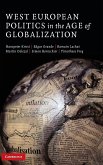The economic and political conditions that have led to the rise of radical right parties exist in similar form and intensity all over Europe. Yet, radical right parties have only been successful in a few countries. The Republikaner party's less than 2% of the vote is much lower than the National Front's high of 15% and the Freedom Party's 27% of the vote in national legislative elections. Why do such a small percentage of voters choose the radical right in Germany? Why is the radical right winning more seats in Austria than in France and Germany? The main argument in this book is that radical right parties will have difficulty attracting voters and winning seats in electoral systems that encourage strategic voting and/or strategic coordination by the mainstream parties. The analysis demonstrates that electoral systems and party strategy play a key role in the success of the radical right.
Hinweis: Dieser Artikel kann nur an eine deutsche Lieferadresse ausgeliefert werden.
Hinweis: Dieser Artikel kann nur an eine deutsche Lieferadresse ausgeliefert werden.
?The recent successes of far-Right parties in Europe are fueling controversy over the cause of this development. Givens examines the voting records of radical Right parties in four European countries and attempts to explain why, in democratic countries facing similar economic conditions, some have been more successful than others. The author uses survey data, case studies, and regression analysis to examine casual relationships, and a model to explain differences in voting.?
Choice
Choice








